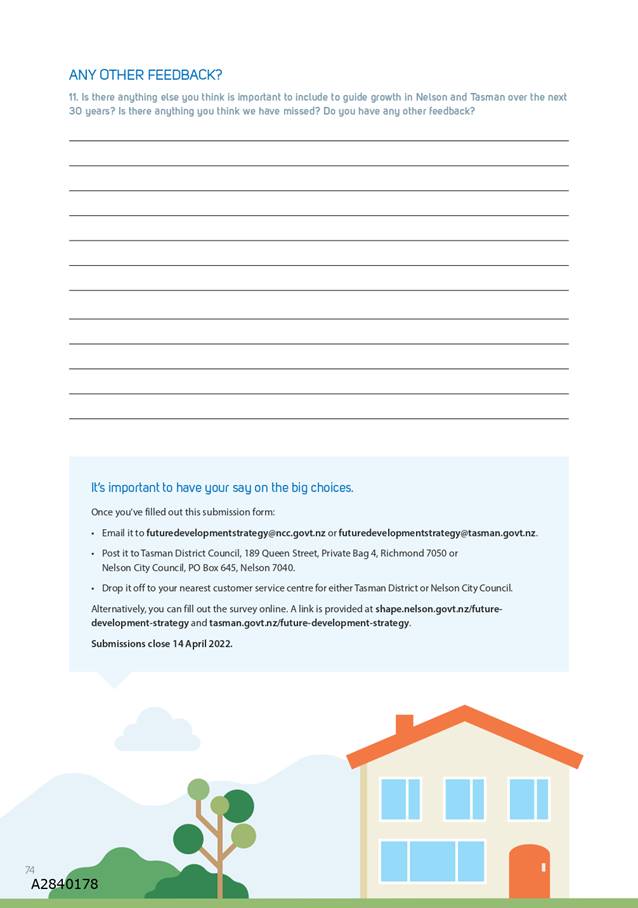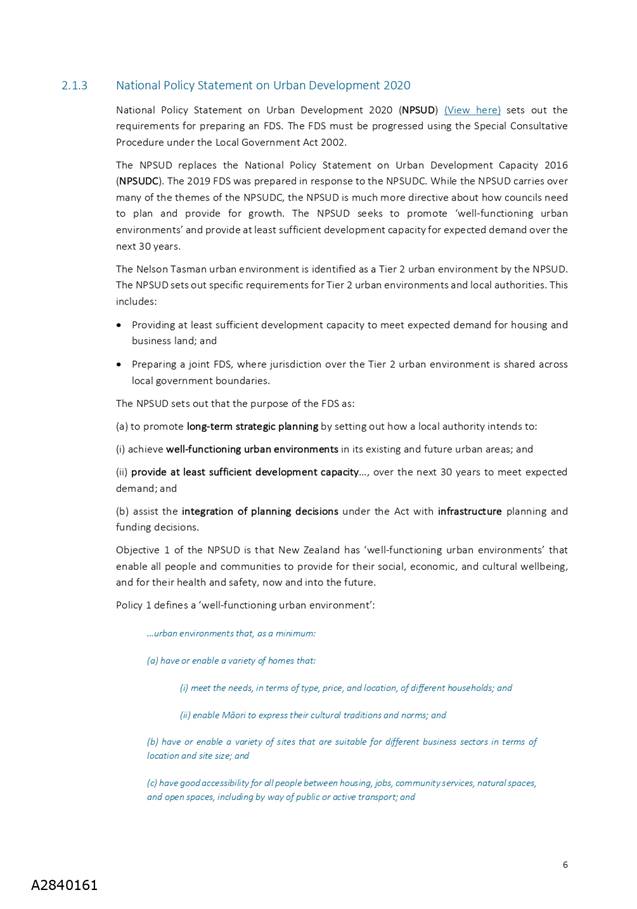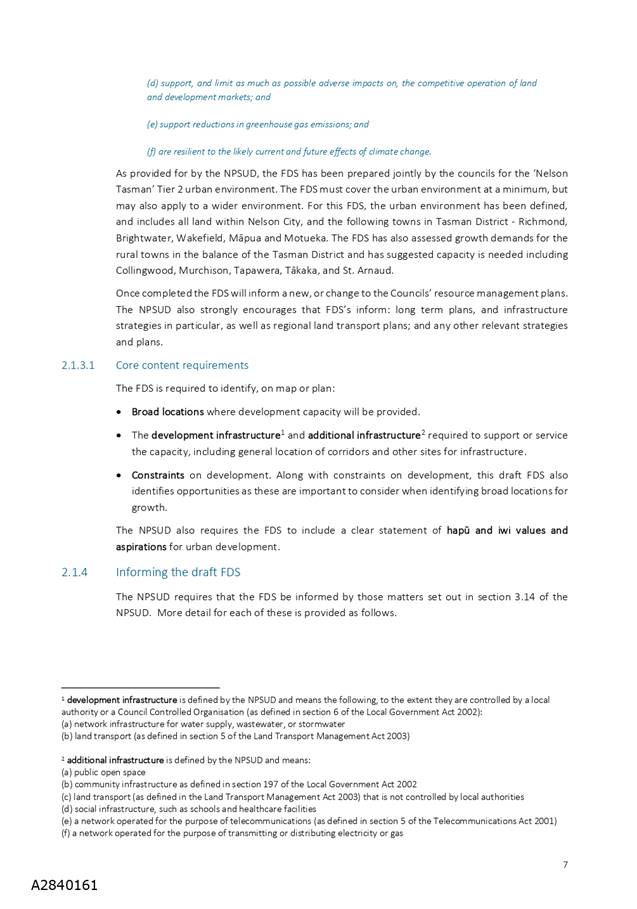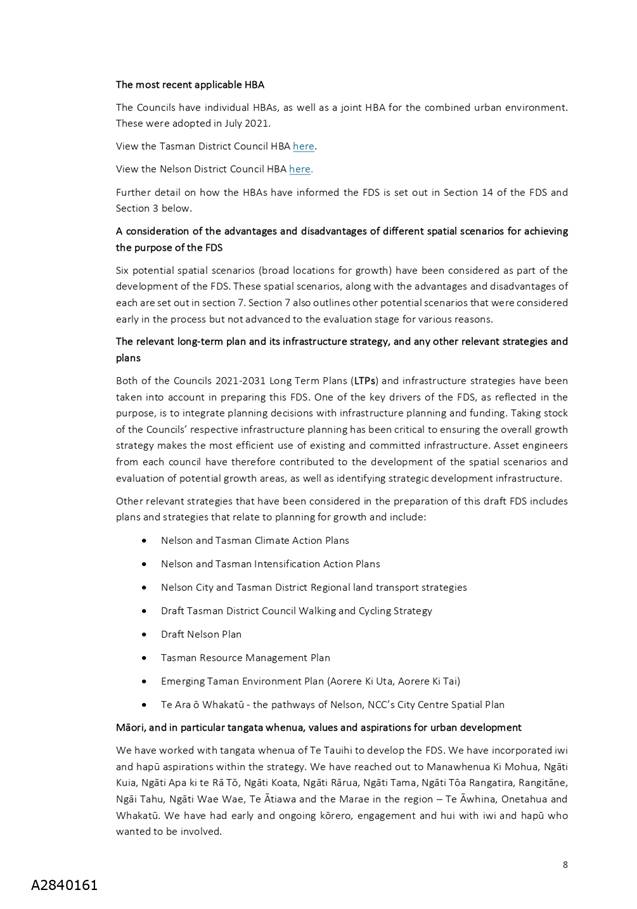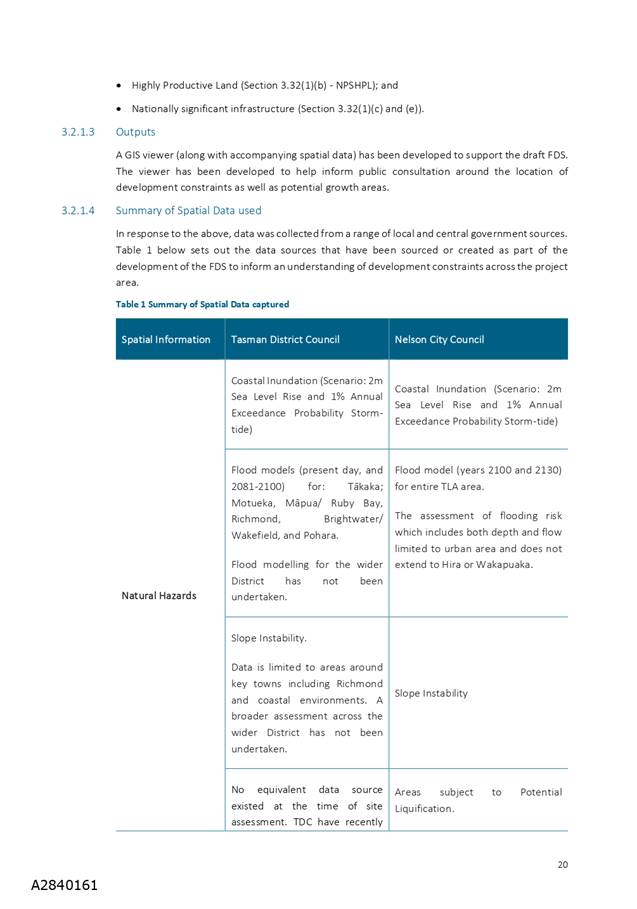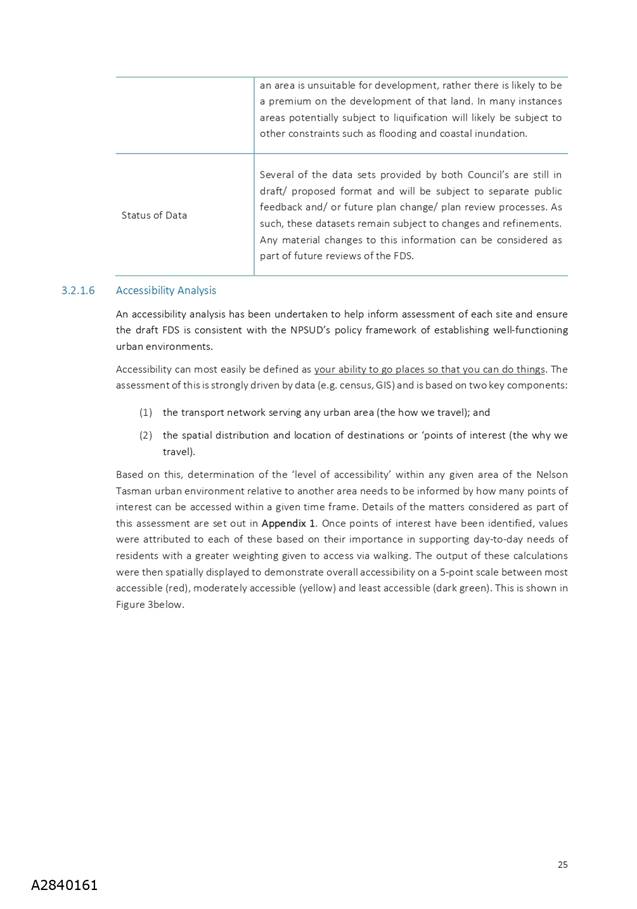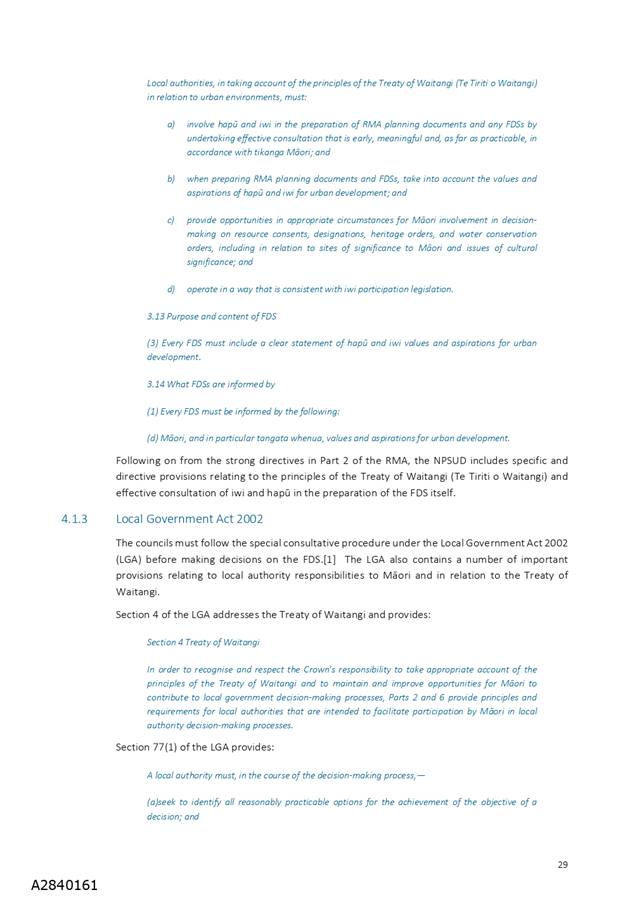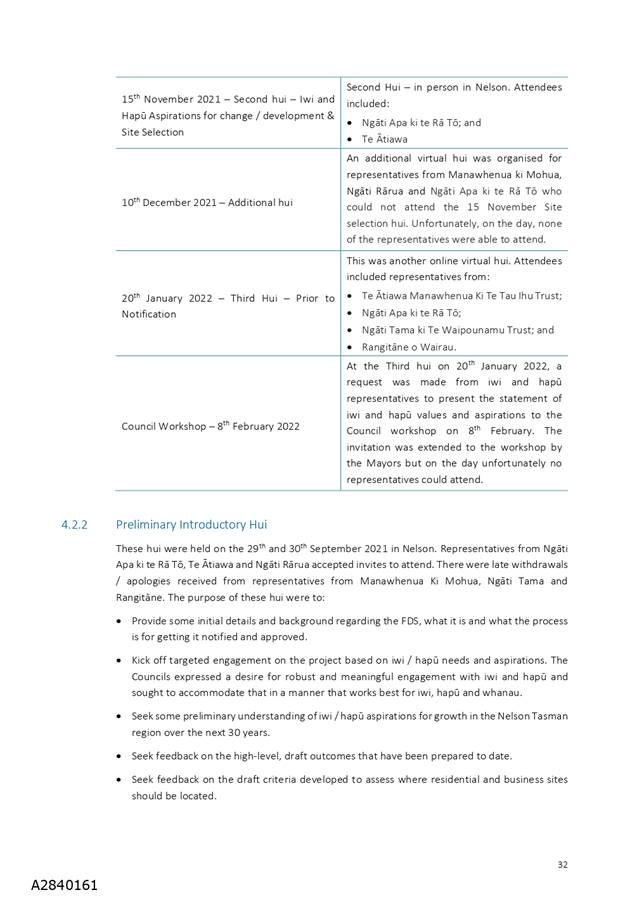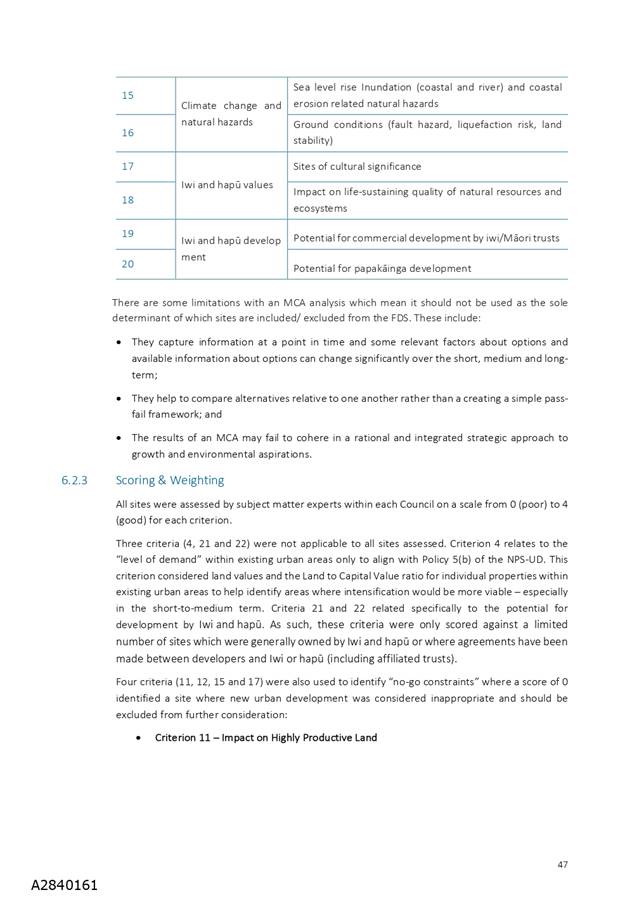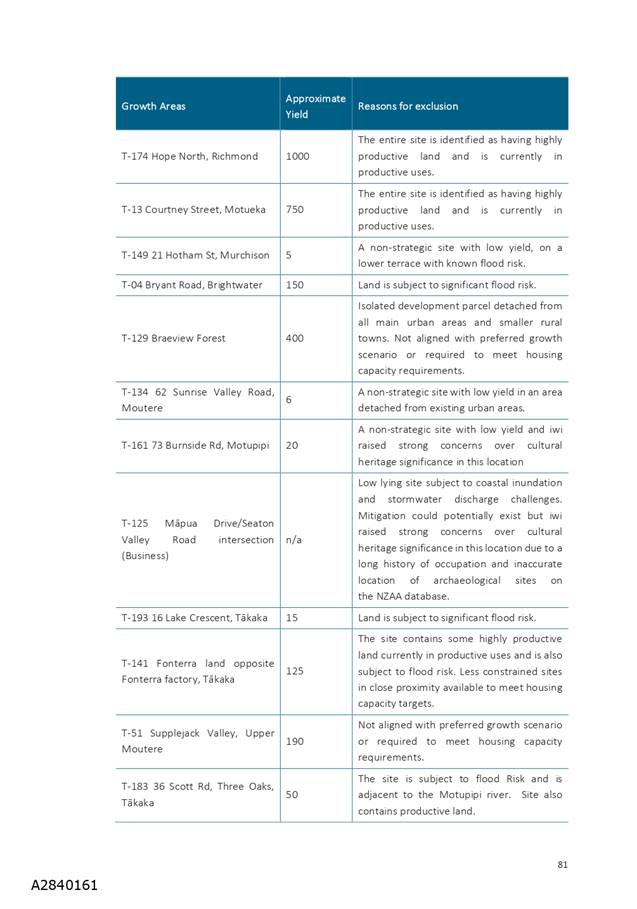Item 5: Nelson Tasman
Future Development Strategy
Joint Committee of Tasman District and Nelson City
Councils
8 March 2022
Report Title: Nelson
Tasman Future Development Strategy
Report Authors: Chris
Pawson - Senior Analyst Environmental Management & Jacqui Deans –
Urban Growth Co-ordinator
Report Number: R26543
1. Purpose
of Report
1.1 To
approve the draft Nelson Tasman Future Development Strategy (draft NTFDS) for
consultation.
1.2 To
approve the commencement of public consultation on the draft NTFDS by way of a
special consultative procedure, in accordance with the proposed consultation
approach.
1.3 To
adopt the draft NTFDS Statement of Proposal for public consultation by way of
the special consultative procedure and to approve the Technical Document in
Attachment 2 as supplementary information to be made available to the public
during the consultation period.
1.4 To
determine that a summary of information is necessary to enable public
understanding of the proposal.
2. Summary
2.1 The
National Policy Statement on Urban Development 2020 (NPS-UD) came into effect
in August 2020, replacing the former National Policy Statement on Urban
Development Capacity 2016. This change results in the requirement for a new
Future Development Strategy (FDS) to be developed and adopted.
2.2 The
draft NTFDS is a 30 year high level strategic plan that indicates future
housing and business growth areas in the region that may be suitable for
rezoning under the Councils’ Resource Management Plans and servicing via
funding in the Councils’ Long Term Plans and planning in the
Infrastructure Strategies.
2.3 The
NPS-UD requires all Tier 2 councils that share jurisdiction over an urban
environment to work together to produce an FDS which sets out a long-term
vision for accommodating urban growth, in time to inform the Councils’
2024 long term plans. Nelson City and part of Tasman District form the
tier 2 Nelson Tasman Urban Environment in the NPS-UD.
2.4 The
NTFDS will ensure both Councils are well placed with an evidence base to inform
reviews and changes to unitary plans, infrastructure strategies and to
facilitate the next round of long-term plans and will be used to inform other
relevant strategies and plans. The NTFDS will:
· promote long-term
strategic planning by setting out how well-functioning urban and rural
environments will be achieved;
· provide at least
sufficient development capacity over the next 30 years (to meet expected
housing and business demand);
· assist with integrating
planning decisions regarding infrastructure planning and funding decisions;
· spatially identify where
capacity will be provided, what infrastructure is required to support the
capacity and any constraints on development; and
· provide a statement of
hapū and iwi values and aspirations for urban development.
2.5 The
core part of the proposal in the draft NTFDS can be summarised as a strategy of
consolidated growth largely focussed along State Highway 6. This
proposal:
· prioritises
intensification in Nelson as well as Richmond, Brightwater, Wakefield,
Māpua and Motueka;
· provides for managed
greenfield expansion around Nelson, Richmond, Brightwater, Wakefield and
Māpua, including opportunities for rural residential development;
· provides for managed
greenfield expansion around the Tasman rural towns of Murchison and Tapawera,
and in Golden Bay, as well as some further development in St Arnaud;
· provides for commercial
and residential growth within existing centres and mixed use areas that will
have a combination of residential and commercial activities; and
· provides for other
business growth (commercial and light industrial) in Richmond, Brightwater and
Wakefield and within the Tasman rural towns of Murchison, Tapawera, St Arnaud,
Takaka and Collingwood, where it is needed to meet local demand.
2.6 The
draft NTFDS also invites submissions on the secondary part of the proposal for
growth, including:
· a potential new
community at Hira to the north of the Nelson City Centre; and
· a potential new
community in the Tasman Village/Lower Moutere area (Braeburn Road).
2.7 The
FDS does not set out the detail of how housing and business areas will be
developed. This detail will be developed through a subsequent series of more
detailed plans and strategies that the Council will prepare and consult on.
3. Recommendation
|
That the Joint Committee of Tasman District and
Nelson City Councils
1. Receives
the report Nelson Tasman Future Development Strategy (R26543) and its attachments (A2840178,
A2840161); and
2. Agrees that a Summary of
Information is required for consultation on the draft Nelson Tasman Future
Development Strategy 2002 in accordance with section 83(1)(a)(ii) of the
Local Government Act 2002; and
3. Agrees that the Summary of
Information contained in the Nelson Tasman Future Development Strategy 2022
Statement of Proposal is a fair representation of the matters in the draft
Strategy and is in an appropriate form to assist the consultation process in accordance
with section 83AA of the Local Government Act 2002; and
4. Approves the draft Nelson Tasman
Future Development Strategy 2022 for consultation; and
5. Approves the consultation approach
(set out in attachment 1) and agrees:
(a) the approach includes
sufficient steps to ensure the Summary of Information contained in the
Statement of Proposal will be widely accessible and will be publicised in a
manner appropriate to its purpose and significance; and
(b) the approach will
result in the Summary of Information contained in the Statement of Proposal
being as widely publicised as is reasonably practicable as a basis for
consultation; and
6. Adopts the Nelson Tasman Future
Development Strategy 2022 Statement of Proposal (containing the Summary of
Information and the draft Nelson Tasman Future Development Strategy) in
Attachment 1 (A2840178) for use in this special consultative procedure in
accordance with sections 83 and 87 of the Local Government Act 2002; and
7. Approves the commencement of a
special consultative procedure on the Statement of Proposal in Attachment 1
(A2840178) with the consultation period to run from 14 March to 14 April
2022; and
8. Approves the Technical Document in
Attachment 2 (A2840161) as supplementary information to be made available to
the public during the consultation period; and
9. Notes that Mayor King of Tasman District Council is
unavailable for membership to the Joint Committee Subcommittee; and
10.
Confirms the membership of the Joint Committee Subcommittee
to oversee the Special Consultative Procedure for the Nelson Tasman Future
Development Strategy 2022:
·
Councillor Stuart Bryant (TDC)
·
Councillor Kit Maling (TDC)
·
Councillor David Ogilvie (TDC)
·
Mayor Rachel Reese (NCC)
·
Councillor Judene Edgar (NCC)
·
Councillor Brian McGurk (NCC)
·
Up to three Mātauranga Māori representatives
11.
Updates the Joint Committee Subcommittee Terms of Reference (A2772759);
and
12. Delegates to the Tasman District and Nelson
City Mayors (or their delegates) the ability to approve any minor edits or
amendments to the Nelson Tasman Future Development Strategy Statement of
Proposal prior to consultation.
|
4. Background
and Discussion
1. 2019 Nelson Tasman Future Development Strategy
4.1 On
26 July 2019 the Joint Committee of the Nelson City and Tasman District
Councils adopted the Nelson-Tasman Future Development Strategy 2019 (2019
NTFDS) under the former National Policy Statement on Urban Development Capacity
(NPS UDC).
4.2 The
2019 NTFDS identified capacity was required for a further 14,249 houses through
a mix of intensification and greenfield expansion. It also identified locations
for new business land (commercial and industrial) at Richmond, Māpua, and
Murchison as well as mixed use opportunities in Nelson.
4.3 The
final NTFDS will replace the 2019 NTFDS.
4.4 The
Joint Nelson Tasman Committee resolved on 10th November 2020 that the Nelson
Tasman Urban Environment comprises the following city and towns: Nelson,
Richmond, Motueka, Māpua, Wakefield, Brightwater, Cable Bay and Hira, in
recognition that these communities are part of the same labour and housing
market, and these areas are or are intended to be predominantly urban in
character.
4.5 The
draft NTFDS has considered what growth might look like under medium and high
population scenarios. Since these are projections the actual rate at which the
regions grow could be different depending on economic conditions, changes to
immigration settings and internal migration patterns. This is why the draft
NTFDS uses two growth scenarios and plans for capacity to meet the higher
growth demand scenario. The medium growth scenario is the same population
growth scenario of both Councils’ Long Term Plans 2021-2051. The NTFDS
must be flexible to respond to growth as it occurs.
4.6 The
draft NTFDS anticipates that, within the combined Nelson Tasman Urban
Environment, there is a need to provide for an extra 17,000 homes under a
medium growth scenario and an extra 24,000 homes under a high growth scenario
over the 30 year assessment period. Within the remaining Tasman rural
towns there is a need to provide 4,026 homes under a medium growth scenario and
5,179 homes under a high growth scenario.
4.7 The
draft NTFDS identifies demand for around 47.8ha of commercial land and 19.6ha
of industrial land over the next 30 years in the Nelson Tasman Urban
Environment under the high growth scenario.
4.8 While
the draft NTFDS plans for the long term high growth scenario, a three-yearly
review of the NTFDS and on-going monitoring of development provides the
opportunity to evaluate how fast the urban area is growing and speed up or slow
down the zoning and servicing of land in response to demand.
2. Outcomes
4.9 A
series of development outcomes have been developed to guide the direction of
the draft NTFDS and assist with determining the most appropriate direction for
growth.
4.10 These
outcomes have been developed with input from iwi, elected members and
stakeholders and are informed by each Council’s Long Term Plans (LTP) and
feedback received to date on each Council’s resource management plan
review.
4.11 The
draft NTFDS seeks to broadly achieve all of the following outcomes:
1. Urban form
supports reductions in GHG emissions by integrating land use and
transport.
2. Existing
main centres including Nelson City Centre and Richmond Town Centre are
consolidated and intensified, and these main centres are supported by a network
of smaller settlements.
3. New
housing is focussed in areas where people have good access to jobs, services
and amenities by public and active transport, and in locations where people
want to live.
4. A range of
housing choices are provided that meet different needs of the community,
including papakāinga and affordable options.
5. Sufficient
residential and business land capacity is provided to meet demand.
6. New
infrastructure is planned, funded and delivered to integrate with growth and
existing infrastructure is used efficiently to support growth.
7. Impacts on
the natural environment are minimised and opportunities for restoration are
realised.
8. Nelson
Tasman is resilient to, and can adapt, to the likely future effects of climate
change.
9. Nelson
Tasman is resilient to the risk of natural hazards.
10. Nelson Tasman's highly
productive land is prioritised for primary production.
11. All change helps to revive
and enhance the mauri of Te Taiao
3. Iwi and hapū values and aspirations
4.12 The
NPS-UD 2020 requires the NTFDS to include a clear statement of hapū and
iwi values and aspirations for urban development.
4.13 Additionally,
Section 77(1)(c) of the LGA requires any significant decision making in
relation to land or a body of water, take into account the relationship of
Māori and their culture and traditions with their ancestral land, water,
sites, waahi tapu, valued flora and fauna, and other taonga.
4.14 The
draft NTFDS has been prepared by the Councils in collaboration with Te Tauihu
iwi and hapū. To prepare the draft NTFDS the project team reached out to
representatives from iwi and hapū including:
· Manawhenua Ki Mohua
· Ngāti Kuia
· Ngāti Apa ki te
Rā Tō
· Ngāti Koata
· Ngāti Rārua
· Ngāti Tama
· Ngāti Tōa
Rangatira
· Rangitāne
· Te Ātiawa
· Ngāti Tahu
· Ngāti Waewae
· Te Āwhina Marae
· Onetahua Marae
· Whakatu Marae
4.15 The
approach has included early and ongoing kōrero, engagement and hui with
iwi and hapū who expressed an interest in engagement on the draft NTFDS.
Several hui were held at key stages to discuss the background of the FDS,
specific criteria for iwi and hapū values, site selection, and iwi and
hapū aspirations over the next 30 years.
4.16 Te
Ātiawa has significant concerns over the three Tasman sites, that these
sites are very sensitive due to along history of spiritual/cultural issues, how
the Councils have obligations to iwi to take into account their spiritual and
cultural views and that careful consideration is being given to the concerns
raised.
4.17 Good
faith dialogue is continuing with Te Ātiawa with a view to finding out
whether a solution can be achieved which benefits all parties and takes into
consideration the cultural sensitivities Te Ātiawa have raised.
4.18 The
final decision whether to include these three sites in the FDS will only be
made following the consultation process and the further discussions with Te
Ātiawa. Section 4 of the draft NTFDS sets out the statement of iwi and hapū
aspirations, prepared collaboratively with those iwi who participated in the
process.
4.19 Iwi
and hapū expressed that the timeframes for the engagement and preparation
of the draft NTFDS were challenging. This meant that not all iwi and hapū
participated in the process, despite all being contacted and offered the
opportunity to participate, with resourcing provided to support their
meaningful engagement. This is largely due to already limited resources for iwi
and hapū and these being stretched given the exceptional amount of
regulatory change currently being pursued at both the central and local
government level. Notwithstanding this, every effort was made throughout the
process to date to facilitate their engagement.
4.20 It
also proved unachievable within the timeframe to get a full consensus on the
statement of iwi and hapū values and aspirations. While the general
structure seemed to be accepted, the precise wording was not fully agreed and
as mentioned above, there was not full participation in the process. The
statement included within the draft NTFDS notes this, and there is further
opportunity for iwi and hapū to provide additional comment once the draft
NTFDS is notified through the Special Consultative Procedure process.
4. Legislation and National Policy Statements
4.21 The
NPS-UD 2020 specifies that the final NTFDS must be considered when preparing or
changing the Council’s resource management plans and ‘it is
strongly encouraged’ that it is used to inform decision making on
policies and strategies and specifically, the LTP and infrastructure strategy
under the Local Government Act 2002 (LGA), and the regional land transport
plans under the Land Transport Management Act 2003 (LTMA).
4.22 The
draft NTFDS has been informed by the following Legislation and National Policy
Statements:
4.22.1 National
Policy Statement on Urban Development 2020
4.22.2 The
Resource Management Act 1991
4.22.3 New
Zealand Coastal Policy Statement 2010 (NZCPS)
4.22.4 National
Policy Statement for Freshwater Management 2020 (NPSFM)
4.22.5 National
Policy Statement on Electricity Transmission 2008 (NPSET)
4.22.6 Local
Government Act 2002
4.23 In
addition, the draft FDS has considered the broad direction set in the draft and
discussion reports for the following proposed NPSs:
4.23.1 National
Policy Statement for Indigenous Biodiversity (NPSIB)
4.23.2 National
Policy Statement for Highly Productive Land (NPSHPL)
5. Infrastructure
4.24 Under
the NPS-UD 2020 the FDS must spatially identify the additional infrastructure
required to support or service that development capacity, along with the
general location of the corridors and other sites required to provide it.
4.25 Section
16.2 of the draft NTFDS details the larger trunk infrastructure required to
support each of the proposed growth areas. Further detail regarding the
infrastructure requirements is contained in the supporting FDS Technical Report
in attachment 2 and additional work to understand the costs of servicing these
areas is being undertaken currently. This cost information is expected to be
available for the deliberation stage of the project, which will be particularly
important as the costs of servicing the possible new towns in the Hira and
Tasman/Lower Moutere area are likely to be high.
6. Spatial scenarios
4.26 Objective
3 of the NPS-UD 2020 requires that regional policy statements and district
plans enable more people to live in, and more businesses and community services
to be located in, areas of an urban environment in which one or more of the
following apply:
· the area is in or near a
centre zone or other area with many employment opportunities;
· the area is
well-serviced by existing or planned public transport; and
· there is high demand for
housing or for business land in the area, relative to other areas within the
urban environment.
4.27 Spatial
scenarios in the draft NTFDS visually shows a proposal for Nelson and Tasman
that provide capacity, choice and incorporate strategic supporting
infrastructure.
4.28 Along
with the outcomes identified above, the spatial scenarios assist in identifying
and understanding trade-offs at a strategic level and working out how new
growth areas and sites considered for growth are distributed.
4.29 The
core part of the proposal in the draft NTFDS can be summarised as one that:
· prioritises
intensification in Nelson as well as Richmond, Brightwater, Māpua,
Wakefield and Motueka;
· provides for managed
greenfield expansion around Nelson, Richmond, Brightwater, Wakefield and
Māpua, including opportunities for rural residential development;
· provides for managed
greenfield expansion around the Tasman rural towns of Murchison and Tapawera,
and in Golden Bay, as well as some further development in St Arnaud;
· provides for commercial
and residential growth within existing centres and mixed use areas that will
have a combination of residential and commercial activities; and
· provides for other
business growth (commercial and light industrial) in Richmond, Brightwater and
Wakefield and within the Tasman rural towns of Murchison, Tapawera, St Arnaud,
Tākaka and Collingwood where it is needed to meet local demand.
4.30 The
core part of the proposal for the combined Urban Environment as shown in
section 7 of the draft NTFDS provides for capacity for 26,000 dwellings made up
of 46% intensification/ infill, 42% residential greenfield, 4% rural
residential and 8% from existing zoned housing capacity outside FDS areas. This
identified capacity meets the identified demand for housing over the 30 year
period of the FDS.
4.31 The
draft NTFDS contains a secondary part of the proposal for consideration,
including:
· the potential for a new
community at Hira to the north of the Nelson City Centre; and
· the potential for a new
community in the Tasman Village/Lower Moutere area (Braeburn Road).
4.32 During
early engagement, Te Ātiawa raised concerns about the Tasman Village/Lower
Moutere proposal. The nature of the concerns relate to a long history of
spiritual/cultural issues associated with an area of battle and it is therefore
a very sensitive area. The Councils have obligations to iwi to take into
account their cultural and spiritual views. Careful consideration is
being given to the concerns raised. Several meetings with Te Atiawa were held
by staff and elected members to discuss these concerns.
4.33 While
the three sites are not part of the Councils’ draft NTFDS core part of
the proposal, the decision has been made to include the three sites in the
draft NTFDS as a secondary part of the proposal during the consultation process
to obtain the wider community views.
4.34 The
managed expansion of other Tasman towns in Murchison, Tapawera and St Arnaud
and in Golden Bay will provide enough capacity to meet demand for each town
under a high growth scenario for both residential and business uses.
4.35 The
draft NTFDS identifies demand for around 47.8ha of commercial land and 19.6ha
of industrial land over the next 30 years in the Nelson Tasman Urban
Environment under the high growth scenario. Capacity analysis undertaken for
the area shows that there is adequate capacity already zoned so no further
development areas are needed for these activities.
7. Potential development sites and constraints
4.36 Nearly
200 potential development sites for housing or business were assessed as part
of the draft NTFDS, 148 in Tasman and 41 in Nelson. A number of these came from
earlier engagement in the FDS development process that had been undertaken with
the developer community, as well as private landowners and the community, and
sites assessed for the 2019 FDS were reassessed. Some sites were also
identified through the early constraints and opportunities mapping exercise.
4.37 The
difference in the number of sites identified in each local authority area is
reflective of the difference in geographical size as well as the constraints of
topography relative to each area.
4.38 The
draft NTFDS does not include sequencing or timing for when growth areas will be
rolled out over the next 30 years, given the need to be responsive to changing
market dynamics in the NPS-UD 2020. This is one of the differences between the
NPS-UDC and the NPS-UD2020.
4.39 Coordinating
development with infrastructure provision for the growth areas identified in
the draft NTFDS will be a critical component of the implementation plan. The
Councils intend to achieve this through a number of approaches, including by:
· undertaking structure planning
for key greenfield areas;
· undertaking
neighbourhood planning for key intensification areas;
· enabling development
through zoning and rule changes to the Councils Resource Management Plans
(RMPs); and
· planning for and funding
the infrastructure through the range of tools available to the Councils.
4.40 To
assist in informing the assessment of potential development sites, constraints
and opportunity mapping and analysis was undertaken across the whole of the two
districts. Understanding Nelson and Tasman’s environmental opportunities
and constraints has helped with identification of suitable locations for growth
shown in section 15 of the draft NTFDS.
4.41 Key
features that limit future expansion include the highly productive land in the
Waimea and lower Moutere/Motueka plains, natural hazards in areas close to the
coast and rivers, and the steep hills in the east. There are strategic
opportunities for future growth in accessible locations within the urban area,
and in locations where the land has limited productive value.
8. Multi Criteria Analysis
4.42 A
Multi Criteria Analysis (MCA) was used to assess growth areas in the 2019 FDS
and a similar approach has been used for the new draft NTFDS, although the
assessment criteria themselves are different, reflecting legislation and
National Policy Statements since 2019.
4.43 Criteria
were formed to reflect the outcomes in section 4.11 above that were developed
with elected members of both Councils. The individual criteria were then
applied to each potential growth site and these individual scores collated to
provide an overall score for the site. All of the potential growth sites have
then been ranked according to the MCA scores and then sites chosen to meet the
required capacity.
4.44 The
scoring of the sites was undertaken by Council officers along with external
specialists where required. Assessment of Iwi cultural and environmental
criteria were undertaken in consultation with Iwi through a series of hui over
the duration of the project to date.
4.45 MCA
have several important characteristics that have influenced the draft NTFDS
development and site selection. In particular, if there are a large number of
criteria, any one criterion can sometimes not influence the total score as much
as desirable. With this in mind, key criteria such as Iwi values, inundation,
coastal hazards and highly productive soils have been weighted individually to
determine whether sites are included. These key criteria are seen as critical
to the viability of development in growth areas and are outlined in more detail
in section 6 of the FDS Technical Report in attachment 2.
9. Consultation and engagement
4.46 The
initial phase of public engagement ran from 4th – 26th October 2021. The
aim of this engagement was to introduce the project to the community, gain
feedback on the overarching FDS strategic outcomes, explain the themes of the
multi-criteria analysis and for the community to put forward any potential
growth sites.
4.47 Community
engagement included a mix of webinars, workshops, Youth Council meetings, media
releases, council newsletters, website updates and social media posts.
4.48 The
NPS-UD 2020 requires Council to engage with an identified list of stakeholders
during the preparation of the draft FDS. A core stakeholder group was
identified with representatives from government agencies, industry groups,
large employers in the region and council-controlled organisations across both
Nelson and Tasman. One online workshop was held with stakeholders as a
group on 23 September 2021 followed by individual workshops and meetings with
stakeholders that wished to be involved further in the process.
4.49 Key
themes have emerged through this, which the draft NTFDS reflects, and which
have informed the development of the draft NTFDS outcomes. These include:
· make efficient use of
infrastructure by intensifying within existing urban areas;
· many stakeholders
favoured providing for growth through intensification rather than new
greenfield development to support reduced emissions and improve accessibility,
but they acknowledged that a mix of housing choices is needed;
· natural hazards, effects
on the natural environment, protecting highly productive land and accessibility
are important considerations for criteria for assessing potential growth areas;
and
· the FDS should be able
to respond to changes in the market
4.50 Each
Council has been engaging with developers throughout the year for other Council
strategies including the Housing and Business Land Assessment, pre-application
discussions and the Infrastructure Acceleration Fund applications. All of these
development sites were included for consideration and assessment in the draft
NTFDS process following these discussions.
10.
Special consultative
procedure
4.51 Under
the NPS-UD when preparing a FDS councils are required to use the special
consultative procedure in sections 83 and 87 of the Local Government Act 2002.
4.52 Section
83(1)(a)(ii) requires local authorities to include a “summary of
information” if it considers it necessary “to enable public
understanding of the proposal”. The draft NTFDS forms part of the
Statement of Proposal and contains a large amount of complex information with
language and terminology that may not be familiar to the public. It is
therefore appropriate to include a Summary of Information in the Statement of
Proposal.
4.53 The
Summary of Information contained in the Statement of Proposal, the draft NTFDS,
and Technical Report supporting the draft NTFDS are included in Attachment 1
and Attachment 2. The Statement of Proposal will be available for distribution
throughout the community, for inspection at Council offices, at the libraries
and on the Councils’ websites.
4.54 Due
to the current red setting in the Covid protection framework and to keep
everyone safe, in person community consultation events on the draft NTFDS will
not take place. Instead, a comprehensive online consultation programme is
planned with details provided in the Statement of Proposal. In summary, the
consultation will take the form of the following:
· nine webinars targeting
each of the main Tasman District towns and geographical areas affected by the
draft NTFDS;
· three webinars targeting
specific groups such as older residents, young people and development interest
groups;
· four webinars for
general community attendance;
· social media campaign
utilising both Councils’ Facebook sites and websites; and
· the public notice of the
Statement of Proposal will be published in the Nelson Mail newspaper.
· Articles will be placed
in Tasman rural newspapers
4.55 To
ensure continuity with the pre-engagement that has been undertaken to date, all
stakeholders involved or invited to the previous stakeholder meetings will be
sent a copy of the consultation material and a webinar will be held with them.
4.56 All
owners of land within greenfield growth areas identified in the draft NTFDS
have been sent letters alerting them to the upcoming consultation so they will
be aware of it and more likely to make a submission if they so desire.
4.57 The
methods summarised above ensure that proposal is widely accessible in both the
Nelson and Tasman regions to a wide range of demographics and stakeholders in
the community in recognition of the purpose and significance of the NTFDS.
4.58 As
required in the Local Government Act 2002 section 83 the consultation period
for submissions will run for at least one month, in this case it will be from
14 March – 14 April 2022 (32 days).
4.59 On
2 November 2021 the Joint Committee of Tasman District and Nelson City Councils
resolved the following:
· Agrees to appoint a
Subcommittee to oversee the Special Consultative Procedure for the draft Future
Development Strategy 2022; and
· Agrees that it would
be appropriate for the Subcommittee to have the skills and experience relating
to Mātauranga Māori; and
· Notes that officers
will be preparing a report for a meeting with Iwi Chairs seeking their views on
the appointment process for up to three Mātauranga Māori
representatives to the Subcommittee and that the outcomes of that discussion
will be reported back to the next Joint Committee in 2022; and
· Agrees that the
Subcommittee is made up of three Elected Members of each Council; including its
Mayor, Deputy Mayor and one other member, and up to three Mātauranga
Māori representatives to be confirmed at the next Joint Committee meeting;
and
· Adopts the draft
Terms of Reference for the Subcommittee, as attached (A2772759); and
· Notes the
Subcommittee will cease to exist once the Nelson Tasman Future Development
Strategy 2022 is adopted.
4.60 Following
this meeting, the Mayor of Tasman became unavailable for appointment to the
subcommittee. The recommendations in this report reflect this change to the
makeup of the subcommittee.
11.
Iwi representatives
4.61 The
original resolution at the 2 November 2021 Joint Committee meeting referred to
“Mātauranga Māori representatives” being appointed to the
subcommittee to hear submissions and deliberate on the final FDS document.
4.62 At
the subsequent Iwi-Council Partnership Group meeting on 1 December 2021, it was
requested that “Iwi representatives” rather than
“Mātauranga Māori representatives” be appointed to
reflect the wider governance representation that Iwi would have in the
subcommittee. The role description sent to Iwi following this meeting reflected
this request.
4.63 Staff
are expecting the nominations prior to the Joint Council meeting and will
update the committee at the meeting.
12.
Implementation
4.64 If
adopted, the FDS will be delivered through a comprehensive implementation plan
prepared by both Councils in partnership with Iwi, key stakeholders and other
infrastructure providers. The implementation plan will sit alongside the FDS
and will be reported on and updated annually.
4.65 Work
on the FDS implementation plan will begin soon after adoption of the final
version of this FDS.
4.66 It
is noted that the Spatial Planning Act is expected to be operative at the time
of the next FDS review in three years’ time. That review will need to
reflect the requirements of the new Act at that time.
5. Options
5.1 The
Joint Committee has the option of approving, or not, the draft FDS for
Consultation or amending the draft before Consultation.
|
Option 1:
|
|
Advantages
|
Ensures compliance
with the NPS-UD 2020, which requires local authorities that share
jurisdiction over an urban environment to work together on an FDS and that
the FDS is prepared in time to inform preparation of the councils’ next
Long Term Plan
Enables the
Councils to coordinate infrastructure investment across the territorial
authority boundary to ensure they provide sufficient residential capacity via
an infrastructure programme that the community can afford.
|
|
Risks and
Disadvantages
|
None.
|
|
Option 2: Amend the
draft NTFDS before consultation
|
|
Advantages
|
Gives the Nelson
Tasman Joint Committee the opportunity to have the draft NTFDS reflect its
preferences more closely.
|
|
Risks and
Disadvantages
|
Depending on the
scope of the amendments, risks the deadline for completion of the NTFDS not
being met.
Potential for
inconsistencies between the final content of the FDS and the analysis
undertaken by the consultants and staff.
|
|
Option 3: Do not approve
the draft FDS for Consultation
|
|
Advantages
|
None.
|
|
Risks and
Disadvantages
|
Noncompliance with
NPS-UD 2020.
Will result in the
project timeline extending past local body elections delaying the adoption of
the final FDS.
Councils would not
have an FDS to inform the next round of long term plans as there will be
insufficient time for any later FDS to meaningfully influence the long term
plan development.
If an FDS is not
adopted at a later date:
· Nelson Tasman Urban Environment may be unable to provide
sufficient feasible development capacity over the next 30 years for housing
and business land; and
· Development may occur in an ad hoc manner creating infrastructure
inefficiencies and potentially affecting the cohesiveness of the community.
Each Council would have less influence over the other’s future release
of land for development.
|
5.2 Council officers
recommend that option one, approval of the draft FDS for consultation, be
adopted.
6. Conclusion
6.1 Continued
high rates of population growth for Tasman and Nelson combined is contributing
to sustained pressure on the housing market and in some places business
land. The draft NTFDS enables a regional approach to managing growth and
infrastructure investment, maximising efficiencies and contains a spatial
growth areas and housing types in accordance with the views expressed by the
communities.
Authors: Chris
Pawson - Senior Analyst Environmental Management
& Jacqui Deans – Urban Growth
Co-
ordinator
Attachments
Attachment 1: A2840178
- 2022 Draft NTFDS and SOP - March 2022 ⇩
Attachment 2: A2840161
- 2022 NTFDS - Draft Technical Document - March 2022 ⇩
|
Important considerations for decision making
|
|
7.1 Fit
with Purpose of Local Government
The matters in this report support the Nelson City
and Tasman District Councils’ work to provide capacity for future
growth and discusses the Government’s requirements of local authorities
for growth planning as set out in sections 30 and 31 of the RMA and its
National Policy Statement on Urban Development 2020.
|
|
7.2 Consistency
with Community Outcomes and Council Policy
The draft FDS is consistent with the community
outcomes and will assist Council to achieve them, particularly:
- Our urban and rural environments are
people friendly, well planned and sustainably managed.
- Our infrastructure is efficient, cost
effective and meets current and future needs.
- Our Council provides leadership and fosters
partnerships, a regional perspective, and community engagement
- Our region is supported by an innovative and
sustainable economy
The Nelson Urban Growth
Strategy (NUGS) was developed in 2006 and guided growth decision making until
the 2019 NTFDS was adopted. The key differences between the NUGS and the
draft NTFDS are that the draft NTFDS now includes a development area in the
Maitai Valley and does not anticipate a new township in Hira. The
inconsistency between these strategies is related to the requirement of the
NPS-UD 2020 to consider accessibility as a priority as well as the high cost
of servicing an area without the necessary infrastructure. It is not intended
to update the NUGS but instead have the NTFDS replace it.
|
|
7.3 Risk
There is some risk that if the Subcommittee
recommends to the Joint Committee to adopt an FDS that is unacceptable to the
Joint Committee, another special consultative procedure would need to be
undertaken for the draft FDS. This will push timelines for the FDS beyond
local body elections and will mean the councils do not have an FDS to inform
their next Long Term Plans.
|
|
7.4 Financial
impact
The implementation and review of the FDS, as well
as integration across both Councils’ other planning documents (LTP,
AMPs RPS, district plans), will occur as part of business as usual.
Continuing to develop an FDS enables the Councils
to eventually coordinate infrastructure investment across the territorial
authority boundary to ensure they provide sufficient residential capacity via
an infrastructure programme that the community can afford.
|
|
7.5 Degree
of significance and level of engagement
This matter is of high significance and as a
result, a special consultative procedure is being undertaken.
The reasons why the decision is considered to be
of high significance are that the proposals contained in the report:
• are likely to have a high level of
public interest
• are likely to be of high interest to
iwi and Māori as they relate to land within the regions
• may lead to future impacts on a large
number of people within the Nelson and Tasman communities
• will have a moderate impact on
community well-being, including provision of housing
• are likely to have moderate to high
future implications for the level of infrastructure provided in the regions
• are likely to lead to future moderate
to high financial implications for the Councils in terms of rates, debt and
development (and financial) contributions, if the proposals are accepted and
proceed.
|
|
7.6 Climate
Impact
The draft FDS considers climate change in its
consideration of minimising greenhouse gas emissions and treatment of the
risks associated with coastal hazards relating to sea level rise.
|
|
7.7 Inclusion
of Māori in the decision making process
Section 4.12-4.19 of this report details the Iwi
engagement that has taken place during development of the draft NTFDS to
date.
|
|
7.8 Delegations
The Joint Committee of
Tasman District and Nelson City Councils has the following delegations to
consider the Future Development Strategy
Areas of Responsibility:
a) Implementation
of the Nelson Tasman Future Development Strategy
Powers to Decide:
b) To adopt,
approve, review and amend the Nelson Tasman Future Development Strategy and
Implementation Plan.
c) In matters relating to the Nelson Tasman Future
Development Strategy, undertake community engagement, including all steps
relating to Special Consultative Procedures or other formal consultation
processes.
|













































































